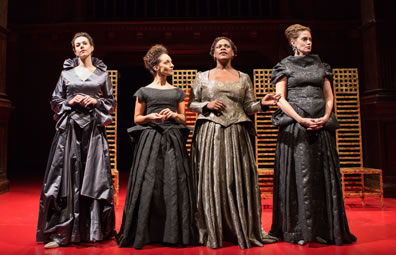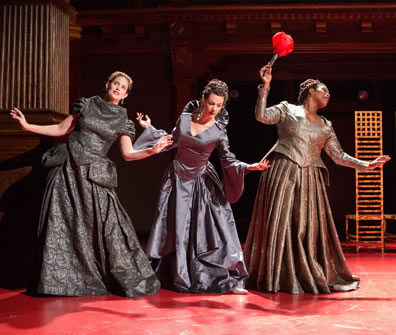texts&beheadings/ElizabethR
Four Queens Make a Winning Hand
Produced by Compagnia de' Colombari
Folger Theatre, Washington, D.C.
Friday, October 3, 2015, H–13&15 (back left stalls)
Created and directed by Karin Coonrod

Queen Elizabeth I (from left, Monique Barbee, Cristina Spina, Ayeje Feamster, and Juliana Francis-Kelly) fill in the biographical data of Elizabeth's life in the Compagnia de' Colombari production of texts&beheadings/ElizabethR at the Folger Theatre. Below, three Elizabeths play the game of courtship in the play's first movement. Photos by Teresa Wood, Folger Theatre.
She steps into the light of a doorway at the back of the stage. Wearing a modern, black, shining-patterned ball gown in a style suggestive of the Louis XVI court, she moves forward and sits in one of four high-backed, dingy gold chairs with red splotches at the front of the otherwise bare stage. She stares indifferently hard at the audience, many still entering the theater.
She steps into the light of the doorway at the back of the stage. Wearing a modern, gun-metal gray, V-neck ball gown with layers of fabric and a ruff-like collar in a style suggestive of a gothic Elizabethan court, she moves forward and sits in another of the chairs. With a slightly tentative expression, she looks out across the audience, many patrons still settling into their seats.
She steps into the light of the doorway at the back of the stage. Wearing a modern, black and silver, paisley-patterned ball gown in a style suggestive of an antebellum dress, she moves forward and sits in another of the chairs. She gazes serenely out at the nearly full theater.
She steps into the light of a doorway at the back of the stage. Wearing a modern, black, jacquard-fabric ball gown with bustle in a style suggestive of the late Victorian age, she moves forward and sits in the last empty chair at the front of the stage. She looks coquettishly at the audience, who now realize the play is about to start.
We are looking at Queen Elizabeth I, the great English monarch of William Shakespeare's time, a woman of so many facets it takes four actresses (respectively, Juliana Francis-Kelly, Monique Barbee, Ayeje Feamster, and Cristina Spina) to play her in the Compagnia de' Colombari production of texts&beheadings/ElizabethR. Created and directed by Karin Coonrod, the play was the Folger Theater's entry in the Women's Voices Theater Festival in the National Capitol Region. The production has since moved to BAM in New York.
With participation from nearly every theater in the region, the festival features more than 50 plays, many of those world premieres, written by women. The credited author of this particular entry is actually Queen Elizabeth. About half of the lines are taken from her own speeches, edicts, letters, prayers, and poetry. Each actress, gorgeously costumed by Oana Botez, takes on the titular character in one of four movements as the other three actresses serve as a chorus, contributing biographical information, line echoes, and occasional casual asides: One calls Elizabeth's poem in reply to a Sir Walter Raleigh poem "a kind of poetry slam," and when the chorus mentions Leicester's entrance on the scene, Feamster delivers a flirtatious, "Oooh, I like him."
Moments like this and a format in which each movement ends with a parlor game of play-acting (each one signaled by the actresses shouting "Game!") give the production a playful tone. However, with a title that creates one word out of decapitations and literature, this play carries an ever-present tone of danger, too. Beheadings become a verbal motif, we occasionally hear a loud, nerve-jangling ka-chang! representing an execution in the next room, and John Conklin's sparse scenic design and Peter Ksander's stark lighting design create a claustrophobic feel. Elizabeth spent her life in actual or metaphorical prisons, from the moment her father declared her a bastard. She lived much of her youth under house arrest, and as a 21-year-old was incarcerated in the Tower of London at the command of her elder sister, Queen Mary. Even as queen, Elizabeth found herself living in something of a cage, especially for a woman of such enormous intellect and free-flowing passions. Ever under threat of execution or assassination, she hears the beheadings as constant reminders that she could easily have been or may yet be the head placed on the block.
The personalities we glimpse in the gazes of the four actresses before the play's start turn out to be character guidelines for the four queens profiled in the four movements. The coquettish Spina takes the lead for the first movement, which focuses on the courtship of the virgin queen. Spina's Elizabeth pronounces that she will be married only to her kingdom—a refrain repeated by the other queens in their own biographical strands—but here it seems to be merely a challenge to her ministers to find a suitable husband, and to the wooers to be that husband. Yet, in this first movement we hear for the first time another oft-repeated line: "Those who touch the scepter of the prince deserve no pity." This queen knows her real place as a ruler, even if others think her place is that of a woman. "Game!" the actresses announce, and the three other Elizabeths pantomime a series of ambassadors of love from various other monarchies, dukedoms, and principalities, passing a large flower from one to the other as they present themselves. However, no prince, duke, or palatine can compete with the Earl of Leicester, her childhood companion and the only man allowed to physically touch Elizabeth. And no man, not even Leicester, can compete with her sense of sovereignty. "I will have one mistress, and no master," she says.
Barbee, who has the tentative demeanor in the opening, takes the lead for the second movement, "Survival." She begins as a 12-year-old writing a letter in Italian to her stepmother, Catharine Parr, then married to the lecherous Lord Admiral Thomas Seymour, requesting protection. Elizabeth gets it, but scandal surrounding her relationship with Seymour, power coups by nobles hoping to plant her in the throne, and subsequent imprisonment expose the teen-age Elizabeth to the rawest forms of political survival (in those days, political survival equated with survival, period). She ends up displaying herself, sans makeup and red hair in full view, as the obvious offspring of Henry VIII. The game in this movement is based on the story of Elizabeth dancing in Seymour's garden as he cuts up her mourning dress, represented in the other Elizabeths ripping fabrics into shreds.
If my retelling seems confusing, welcome to our states of mind. The play's format in thematic-driven movements makes for a chronologically disjointed storyline, and within movements the chronology often jumps about or, as in this movement, doubles back on itself. We are supposed to follow the thematic strands of Elizabeth's life instead of looking for a biographical timeline, but that demands extra effort on the part of the audience. Unfortunately, as we struggle to find the play's track, we can't fully appreciate the subtle work Barbee does in presenting her Elizabeth's deep fear, stout courage, and lineal pride sharing the same countenance.
We move on to "Prayer" for the next movement, and the serene Feamster becomes lead queen. We see her survival from smallpox and her long-form prayer comparing herself to Daniel being delivered from the "den of the greedy and raging lions" (which was historically a public prayer on the eve of her coronation). After seeing Elizabeth as a manipulative flirt and then as a scheming survivor, in this movement we see a majesty of supreme confidence relying on an unwavering faith in God. However, in Feamster's portrayal, we can't shake the sense that the line between show and truth is blurred. "Game!" Calling this game "Dissing Elizabeth," each of the queens read through a stack of parchments, each containing an insult written about Elizabeth from various princes, nobles, lords, and the pope, the last worthy of a website comment board troll.
 The fourth movement is titled "Sovereignty," and it features the iron-guised Francis-Kelly in the lead role. She presents cold steel when railing at Leicester for choosing his self-interest over service to the nation and, weeks later, molten affection for the same Leicester, greeting him simply as "Robert." This is the astute politician dealing with the issue of Mary, Queen of Scots (and sending overtures to Mary's son, James VI of Scotland—later James I of England—who wasn't too keen on having mom around himself). This is the ruthless queen whose creed is, "Suffer or strike! In order not to be struck, strike!" This is the stateswoman who notes that Philip of Spain has tried 15 times to have her assassinated: "He must love me." This is the witty woman who brags that "There is no marvel in a woman learning to speak, but there would be in teaching her to hold her tongue." This is the Machiavellian monarch who grows tired of her favorite courtier, the Earl of Essex, saying of him that "he hath played long enough upon me, and now I mean to play awhile upon him," ultimately turning her decree that "those who touch the scepter of the prince deserve no pity" on him. Ka-chang! Francis-Kelly doesn't appear too discomforted by that sound in this movement.
The fourth movement is titled "Sovereignty," and it features the iron-guised Francis-Kelly in the lead role. She presents cold steel when railing at Leicester for choosing his self-interest over service to the nation and, weeks later, molten affection for the same Leicester, greeting him simply as "Robert." This is the astute politician dealing with the issue of Mary, Queen of Scots (and sending overtures to Mary's son, James VI of Scotland—later James I of England—who wasn't too keen on having mom around himself). This is the ruthless queen whose creed is, "Suffer or strike! In order not to be struck, strike!" This is the stateswoman who notes that Philip of Spain has tried 15 times to have her assassinated: "He must love me." This is the witty woman who brags that "There is no marvel in a woman learning to speak, but there would be in teaching her to hold her tongue." This is the Machiavellian monarch who grows tired of her favorite courtier, the Earl of Essex, saying of him that "he hath played long enough upon me, and now I mean to play awhile upon him," ultimately turning her decree that "those who touch the scepter of the prince deserve no pity" on him. Ka-chang! Francis-Kelly doesn't appear too discomforted by that sound in this movement.
The last game is "Dressing the queen." As Francis-Kelly stands on a platform, the other queens go through an inventory of clothes, item by item, and mime placing each piece of clothing and accessory on her, starting with panties and ending with a scepter and orb. As spots come up through the stage's back door, the other queens hold a mirror up to Francis-Kelly's Elizabeth, reflecting the light as a royal glow upon her face. Francis-Kelly then recites the end of Elizabeth's famous speech opening Parliament. "I have already joined myself in marriage to a husband, namely the kingdom of England." After a stirring speech of patriotism and expression of trust in the men governing her realm, she dictates that each one of those men pass by her so that they may kiss her hand. It's delivered as a statement of humility, but Francis-Kelly's gaze shifts almost imperceptibly to haughtiness as she holds her hand out to the audience.
"Game!"
Eric Minton
October 26, 2015
Comment: e-mail [email protected]
Start a discussion in the Bardroom



 Find additional Shakespeareances
Find additional Shakespeareances